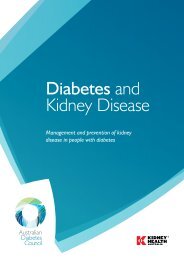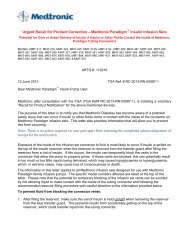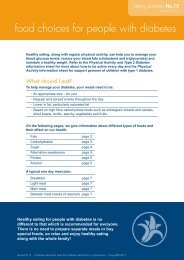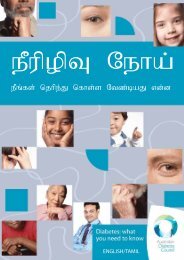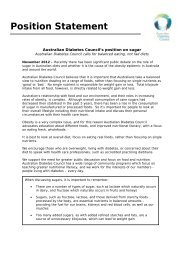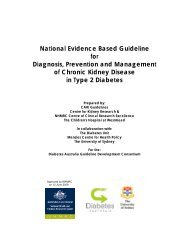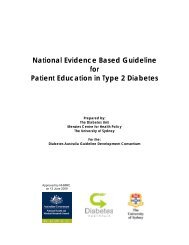O MeA e tAtAU OnA e IlOA - Australian Diabetes Council
O MeA e tAtAU OnA e IlOA - Australian Diabetes Council
O MeA e tAtAU OnA e IlOA - Australian Diabetes Council
Create successful ePaper yourself
Turn your PDF publications into a flip-book with our unique Google optimized e-Paper software.
Types of diabetes - continued<br />
Gestational <strong>Diabetes</strong><br />
This type of diabetes occurs during pregnancy and usually goes<br />
away after the baby is born.<br />
In pregnancy, the placenta produces hormones that help the baby<br />
to grow and develop. These hormones also block the action of the<br />
mother’s insulin. As a result, the need for insulin in pregnancy is<br />
two to three times higher than normal. If the body is unable to<br />
produce enough insulin to meet this extra demand, gestational<br />
diabetes develops.<br />
Screening for gestational diabetes occurs around the 24th to 28th<br />
week of pregnancy. Gestational diabetes may re-occur at the next<br />
pregnancy.<br />
Blood glucose (sugar) levels that remain above target range may<br />
result in bigger babies, which can make birth more difficult. It can<br />
also increase the risk to the baby of developing diabetes in later life.<br />
What do you need to do if you have been diagnosed with gestational diabetes?<br />
It is necessary to see a diabetes educator, dietitian, endocrinologist and obstetrician.<br />
The management includes healthy eating for the mother, moderate exercise plus regular<br />
monitoring of blood glucose levels.<br />
It is a good idea to have small frequent meals throughout the day that are nutritious for<br />
you and your baby, rather than three big meals. This will ease the insulin demand on the<br />
pancreas.<br />
Those most at risk for developing gestational diabetes are:<br />
• Women over 30 years of age<br />
• Women with a family history of type 2 diabetes<br />
• Women who are overweight<br />
• Aboriginal or Torres Strait Islander women<br />
• Certain ethnic groups, in particular Pacific Islanders, people from<br />
the Indian subcontinent and people of Asian origin<br />
• Women who have had gestational diabetes during previous<br />
pregnancies.<br />
Women who have had gestational diabetes are at increased risk of developing type 2<br />
diabetes. It is strongly recommended to have a follow up Oral Glucose Tolerance Test 6-8<br />
weeks after the baby is born, then every 1-2 years.<br />
16




